GMC SIERRA 1993 Owners Manual
Manufacturer: GMC, Model Year: 1993, Model line: SIERRA, Model: GMC SIERRA 1993Pages: 436, PDF Size: 23.88 MB
Page 91 of 436
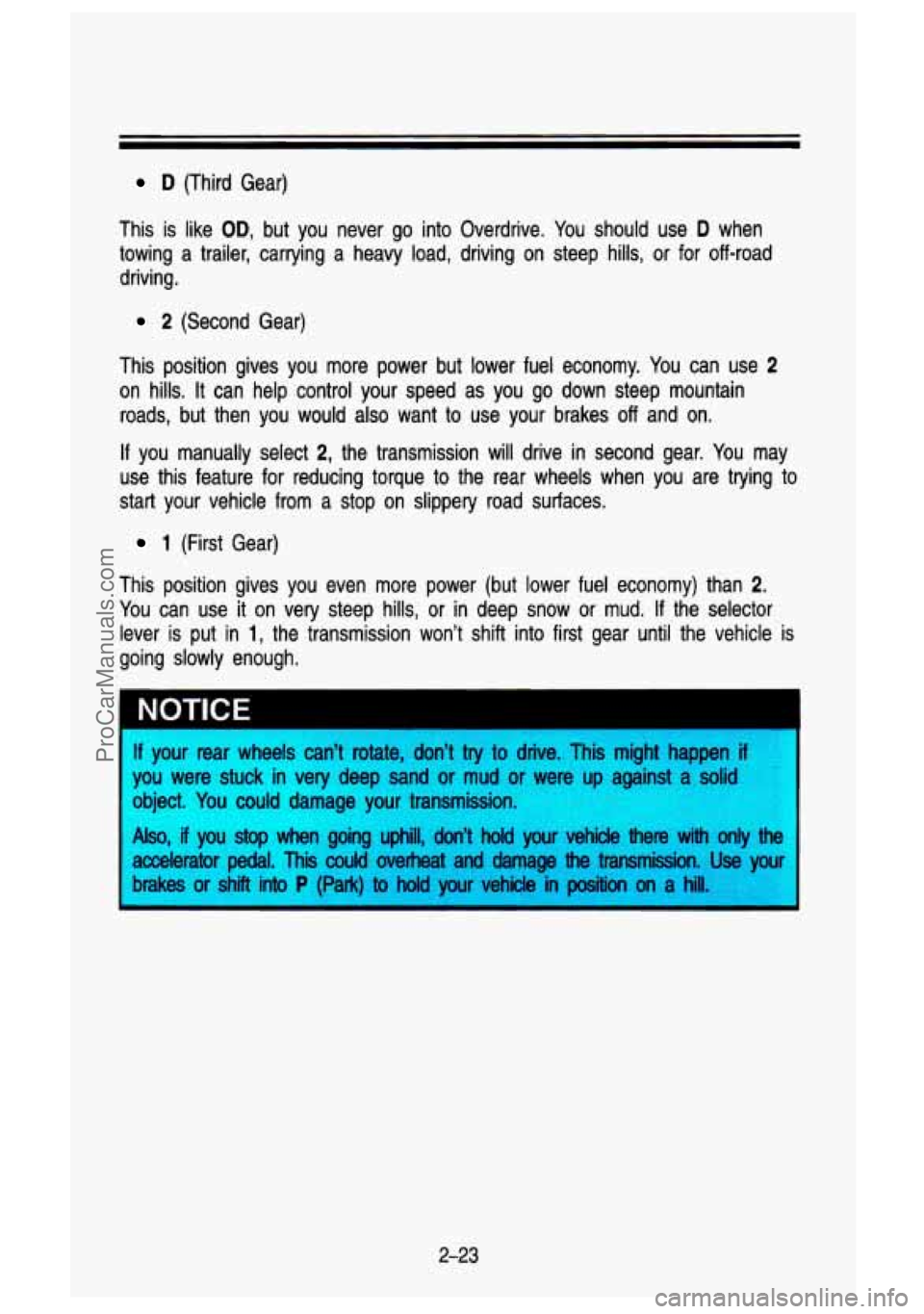
D (Third Gear)
This is like
OD, but you never go into Overdrive. You should use D when
towing a trailer, carrying a heavy load, driving on steep hills, or for off-road
driving.
2 (Second Gear)
This position gives you more power but lower fuel economy. You can use
2
on hills. It can help control your speed as you go down steep mountain
roads, but then you would also want to use your brakes
off and on.
If you manually select 2, the transmission will drive in second gear. You may
use this feature for reducing torque to the rear wheels when you are trying
to
start your vehicle from a stop on slippery road surfaces.
1 (First Gear)
This position gives you even more power (but lower fuel econo\
my) than
2.
You can use it on very steep hills, or in deep snow or mud. If the selector
lever
is put in 1, the transmission won’t shift into first gear until the vehic\
le is
going slowly enough.
NWTIGE
If your rear wheels can’t rotate, don’t try to drive. This might happen if
you were stuck in very deep sand or mud or were up against a. solid
object. You could damage your transmission.
AWZ , <,*,~l,<.,. ...
Also, if you stop when going uphill, don’t hold your vehic there with only the
accelerator pedal.
This could overheat and damage ,the transmission. Use your
brakes or shii into P (Park) to hdd your vehicle in position on a hill.
.,$*’,,&:&> ._,, , . ~ ~ ,>&:a
2-23
ProCarManuals.com
Page 92 of 436

Features & Controls
FivemSpeed Manual lZransmission
(Without Low Gear)
I
K2220
This is your shift pattern. Here’s how to operate your tran\
smission:
K2386
1 (First Gear)-Press the clutch pedal and shift into 1. Then, slowly let
up on the clutch pedal as you press the accelerator pedal.
You can shift into 1 when you’re going less than 20 mph (32 kmlh). If
you’ve come to a complete stop and it’s hard to shift into 1, put the
shift lever in Neutral and let up on the clutch. Press the c\
lutch pedal back down. Then shift into
1.
2-24
ProCarManuals.com
Page 93 of 436
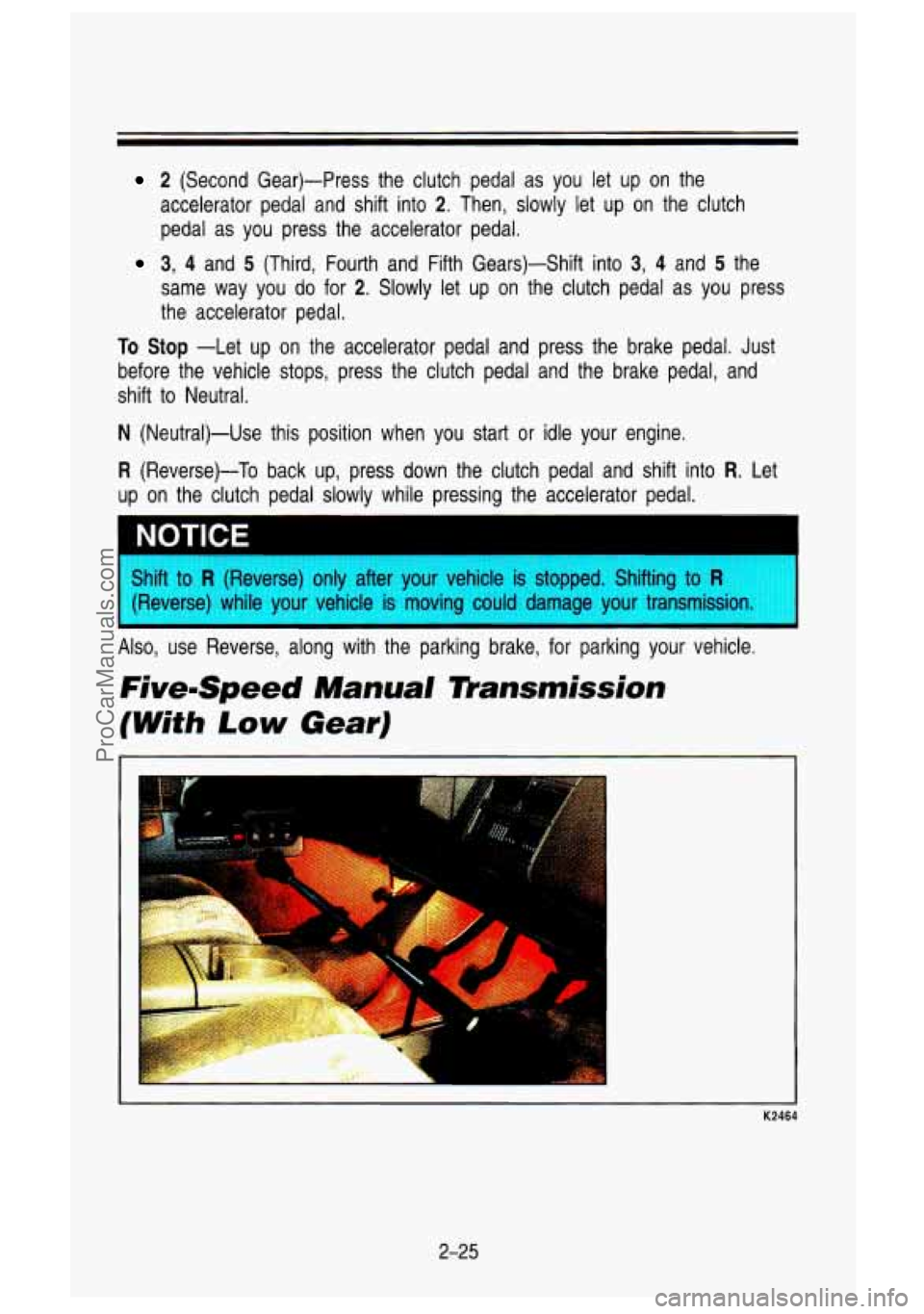
2 (Second Gear)-Press the clutch pedal as you let up on the
accelerator pedal and shift into
2. Then, slowly let up on the clutch
pedal as you press the accelerator pedal.
3, 4 and 5 (Third, Fourth and Fifth Gears)-Shift into 3, 4 and 5 the
same way you do for
2. Slowly let up on the clutch pedal as you press
the accelerator pedal.
To Stop -Let up on the accelerator pedal and press the brake pedal. Just
before the vehicle stops, press the clutch pedal and the brake pedal, and
shift to Neutral.
N (Neutral)-Use this position when you start or idle your engine,
R (Reverse)-To back up, press down the clutch pedal and shift into R. Let
up on the clutch pedal slowly while pressing the accelerator p\
edal.
Shift to
R (Reverse) only after your vehicle is stopped. Shifting to R
(Reverse) while your vehicle is moving could damage your transmission
Also, use Reverse, along with the parking brake, for parking your vehicle.
FivemSpeed Manual 7Fansmission
(With Low Gear)
e
K2464
2-25
ProCarManuals.com
Page 94 of 436
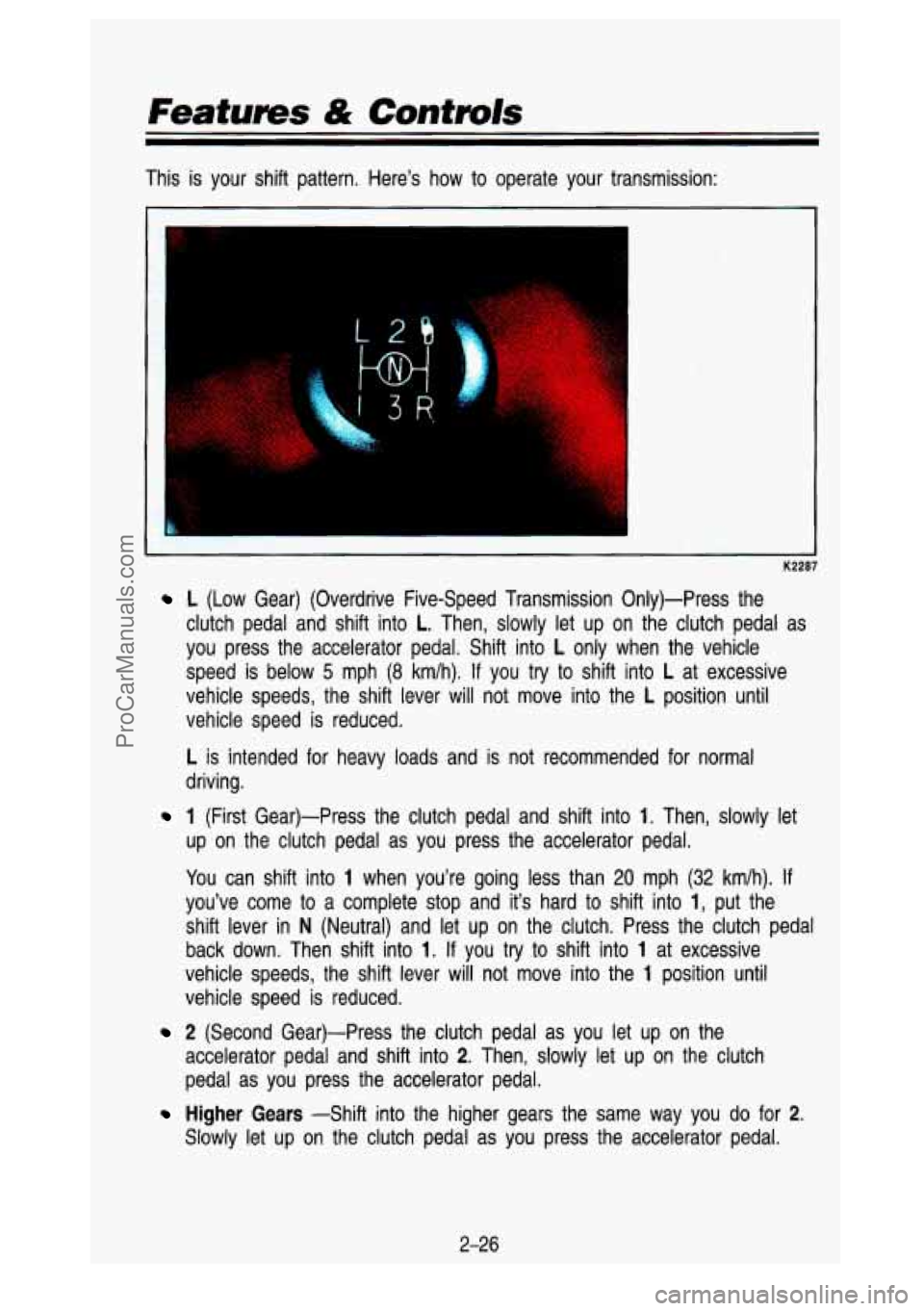
This is your shift pattern. Here’s how to operate your transmission:
I IC2287
L (Low Gear) (Overdrive Five-Speed Transmission Only)-Press the
clutch pedal and shift into
L. Then, slowly let up on the clutch pedal as
you press the accelerator pedal. Shift into
L only when the vehicle
speed is below
5 mph (8 km/h). If you try to shift into L at excessive
vehicle speeds, the shift lever will not move into the
L position until
vehicle speed is reduced.
L is intended for heavy loads and is not recommended for normal
driving.
1 (First Gear)-Press the clutch pedal and shift into 1. Then, slowly let
up on the clutch pedal as you press the accelerator pedal.
You can shift into
1 when you’re going less than 20 mph (32 kmlh). If
you’ve come to a complete stop and it’s hard to shift into 1, put the
shift lever in
N (Neutral) and let up on the clutch. Press the clutch pedal
back down. Then shift into
1. If you try to shift into 1 at excessive
vehicle speeds, the shift lever will not move into the
1 position until
vehicle speed is reduced.
accelerator pedal and shift into
2. Then, slowly let up on the clutch
pedal as you press the accelerator pedal.
Higher Gears -Shift into the higher gears the same way you do for 2.
Slowly let up on the clutch pedal as you press the accelerato\
r pedal.
2 (Second Gear)-Press the clutch pedal as you let up on the
2-26
ProCarManuals.com
Page 95 of 436
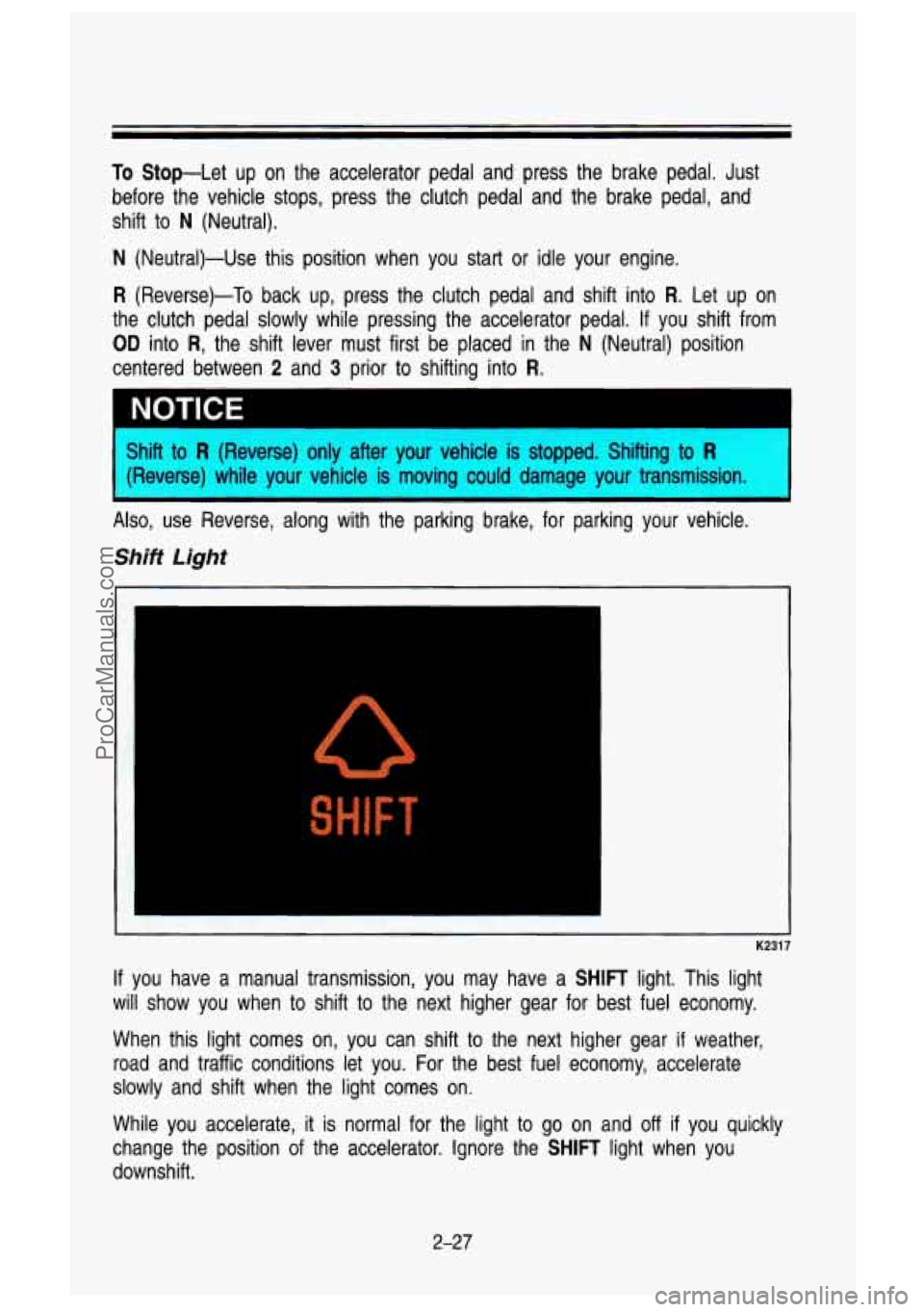
To Stop-Let up on the accelerator pedal and press the brake pedal\
. Just
before the vehicle stops, press the clutch pedal and the brake pedal, and
shift to
N (Neutral).
N (Neutral)-Use this position when you start or idle your engine.
R (Reverse)-To back up, press the clutch pedal and shift into R. Let up on
the clutch pedal slowly while pressing the accelerator pedal. If you shift from
OD into R, the shift lever must first be placed in the N (Neutral) position
centered between
2 and 3 prior to shifting into R.
NOTICE I
Shift to R (Reverse) only after your vehicle is stopped. Shifting to R
(Reverse) while vour vehicle is movina could damaae vour transmission.
- -
Also, use Reverse, along with the parking brake, for parking your ve\
hicle.
Shift Light
I K2317
If you have a manual transmission, you may have a SHIFT light. This light
will show you when to shift to the next higher gear for best fuel economy.
When this light comes on, you can shift to the next higher gear
if weather,
road and traffic conditions let you. For the best fuel economy, accelerate
slowly and shift when the light comes on.
While you accelerate, it is normal for the light to go on and
off if you quickly
change the position
of the accelerator. Ignore the SHIFT light when you
downshift.
2-27
ProCarManuals.com
Page 96 of 436
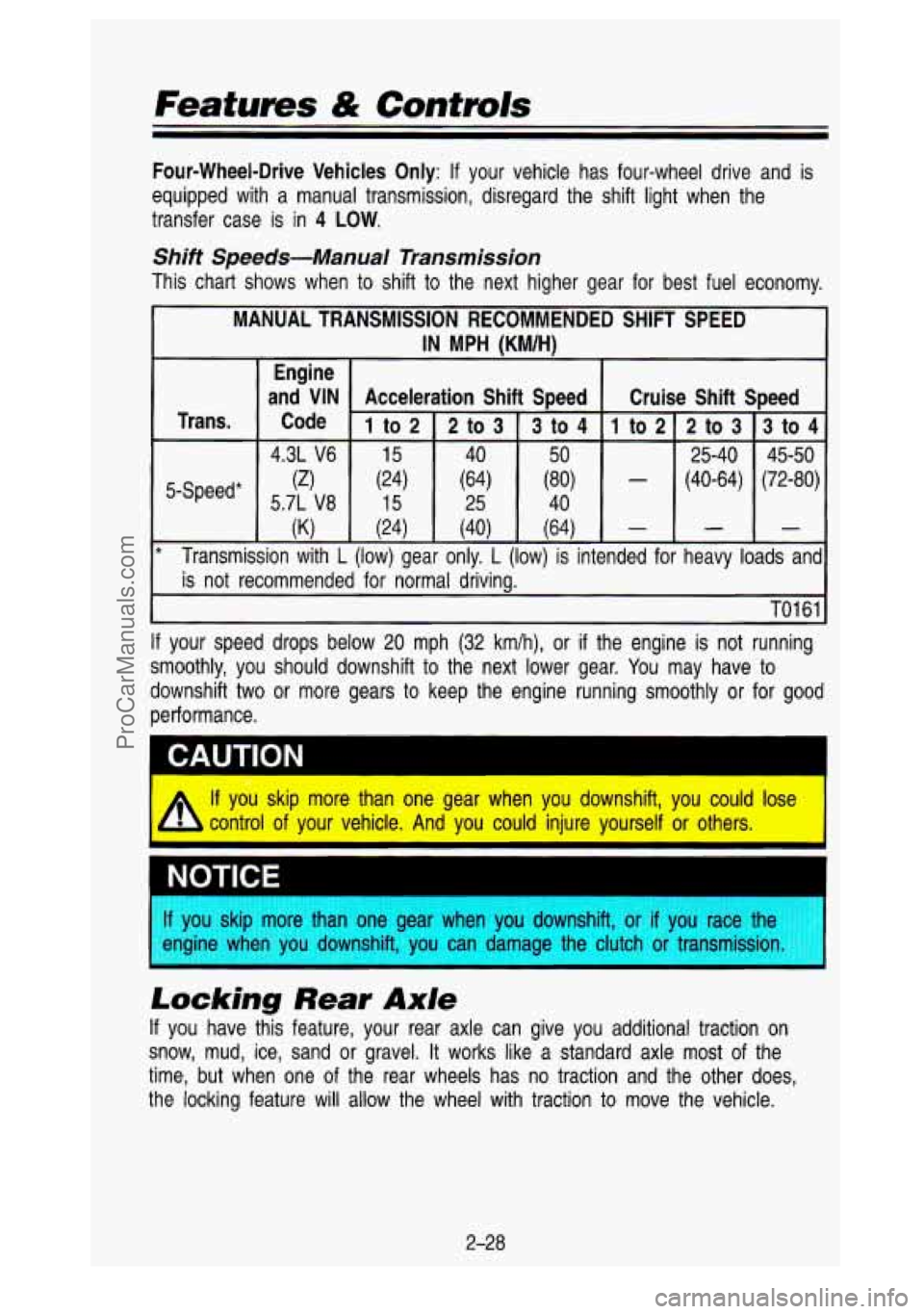
Features & Controls
Four-Wheel-Drive Vehicles Only: If your vehicle has four-wheel drive and is
equipped with a manual transmission, disregard the shift light \
when the
transfer case is in
4 LOW.
Shift Speeds-Manual Transmission
This chart shows when to shift to the next higher gear for best fuel economy.
MANUAL TRANSMISSION RECOMMENDED SHIFT SPEED
IN MPH (KMIH)
Engine
and
VIN
45-50 25-40 50 40 15
4,3L
V6
3 to 4 2 to 3 1 to 2 3 to 4 2 to 3 1 to 2 Code
Trans. Cruise Shift Speed
Acceleration Shift Speed
(4
- (64) (40) (24) (K)
(72-80)
(40-64) - (80) (64)
(24)
5-Speed*
40 25 15 5.7L V8
- -
* Transmission with L (low) gear only. L (low) is intended for heavy loads and
is not recommended for normal driving.
I TO1 61 I
If your speed drops below 20 mph (32 km/h), or if the engine is not running
smoothly, you should downshift to the next lower gear. You may have to
downshift two or more gears
to keep the engine running smoothly or for good
performance.
I A If you skip more than one gear when you downshift, you could lose
I & control of your vehicle: And you could injure yourself or others. I
I Ju skip more than one gear when you downshift, or if you race the
;,,,ine when you downshift, you can damage the clutch or transmission. \
I
Locking Rear Axle
If you have this feature, your rear axle can give you additional \
traction on
snow, mud, ice, sand or gravel.
It works like a standard axle most of the
time,
but when one of the rear wheels has no traction and the other does,
the locking feature
will allow the wheel with traction to move the vehicle.
2-28
ProCarManuals.com
Page 97 of 436

Parking Brake
K2221
To set the parking brake:
Hold the regular brake pedal down with your right foot. Push down the
parking brake pedal with your left
foot. If the ignition is on, the brake system
warning light will come
on.
To release the parking brake:
Hold the regular brake pedal down. Pull the lever marked RELEASE.
Driving with the parking brake on can cause your rear brakes to overheat.
You may have to replace them, and you also da other p;
of I
your vehicle.
’ ‘
If you are on a hill:
See “Parking on Hills” in the Index. That part shows how to turn your front
wheels.
If you are towing a trailer and are parking on any hill:
See “Towing a Trailer” in the Index. That part shows what to do first to keep
the trailer from moving.
2-29
ProCarManuals.com
Page 98 of 436

Features & Controls
Propshaft Brake Burnish Procedure
If you have a 3500 HD Model, it is recommended that the propshaft mounted
parking brake be burnished as part of the new vehicle break in. The parking
brake
will work best after it has been burnished following these instructions.
Make
10 stops, using the parking brake foot pedal, from 20 mph (32 k\
m/h)
about 2
112 miles (4 km) apart. In between stops, drive the vehicle at 20
mph (32 kmlh).
Torque Lock
The parking brake should be set first whenever leaving the dri\
ver’s seat. If
you are parked on a hill and the transmission is placed in P (Park) before
the parking brake is set, the weight of the vehicle may put too much force
on the parking pawl in the transmission.
It may be difficult to pull the selector
lever out of
P (Park). This is called “torque lock.” To prevent this, the parking
brake should be set
BEFORE moving the selector lever to P (Park).
When preparing
to move the vehicle, the selector lever should be moved out
of
P (Park) BEFORE releasing the parking brake. Set the parking brake first,
then release the transmission from
P (Park), even on level surfaces.
If “torque lock” does occur, you may have to have another vehicle nudge
your vehicle uphill a little
to take some of the pressure off the transmission
while you pull the selector lever out of
P (Park).
Shifting Into P (Park) (Automatic Transmission Models Only)
1 CAUTION
It can be dangerous to get out of your vehicle if the shift lever is not
fully in
P (Park) with the parking brake firmly set. Your vehicle can
roll.
If you have left the engine running, the vehicle can move suddenly.
You
or others could be injured. TO be sure your vehicle won’t move,
when you’re
on fairly level ground, use the steps that follow.
If you have four-wheel drive and your transfer case is in N (Neutral),
your vehicle will be free to roll-even if your shift lever is in P
{Park). So, be sure the transfer case is in a drive gear-not N
(Neutral).
If you are parking on a hill, or if you’re pulling a trailer, also see
“Parking on Hills9’ or “Towing a Trailer” in the Index. I
2-30
ProCarManuals.com
Page 99 of 436
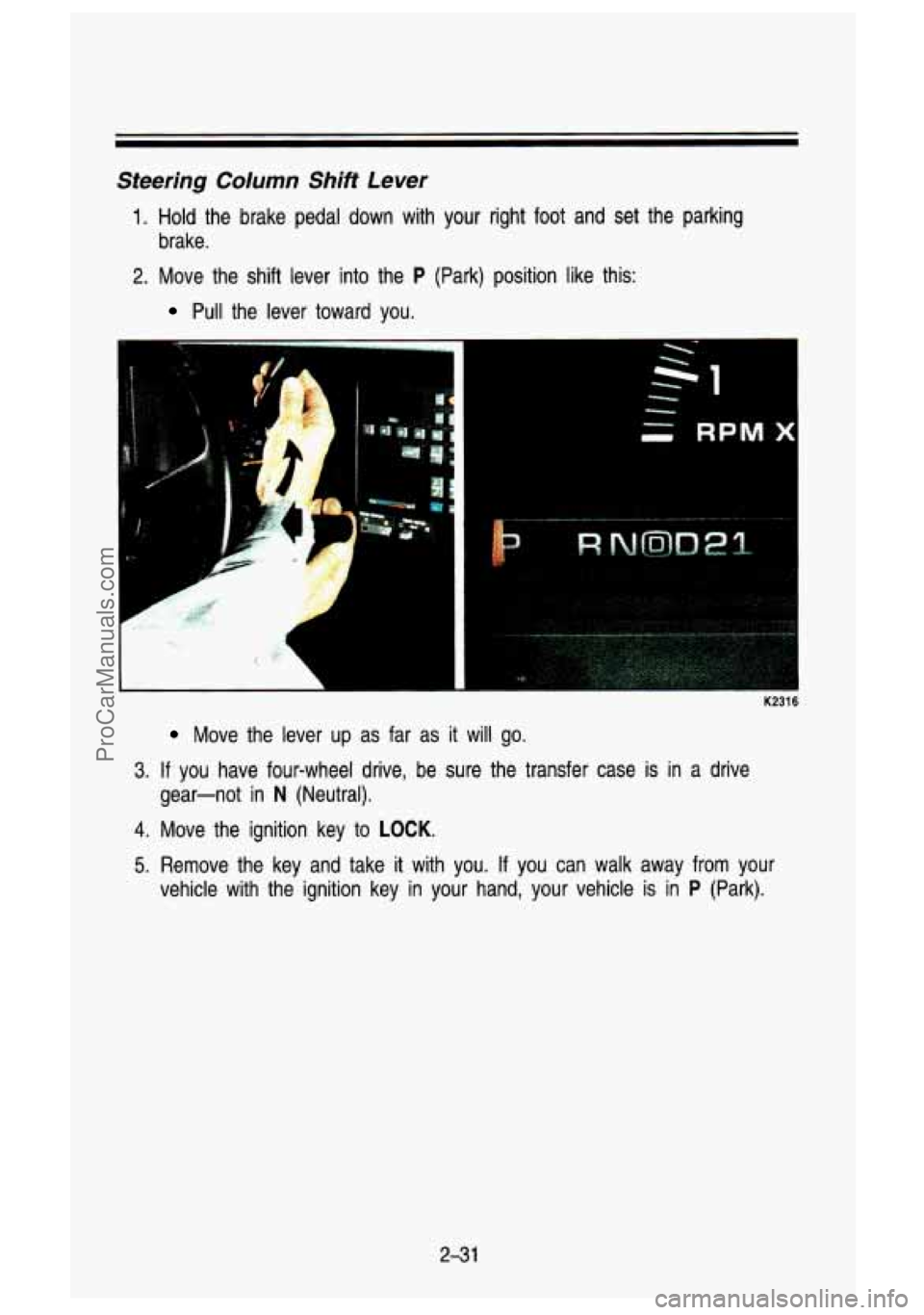
Steering Column Shift Lever
1. Hold the brake pedal down with your right foot and set the parking
brake.
2. Move the shift lever into the P (Park) position like this:
Pull the lever toward you.
~- - --
w KL" I"
Move the lever up as far as it will go.
3. If you have four-wheel drive, be sure the transfer case is in a drive
4. Move the ignition key to LOCK.
5. Remove the key and take it with you. If you can walk away from your
vehicle with the ignition key
in your hand, your vehicle is in P (Park).
gear-not
in N (Neutral).
2-31
ProCarManuals.com
Page 100 of 436
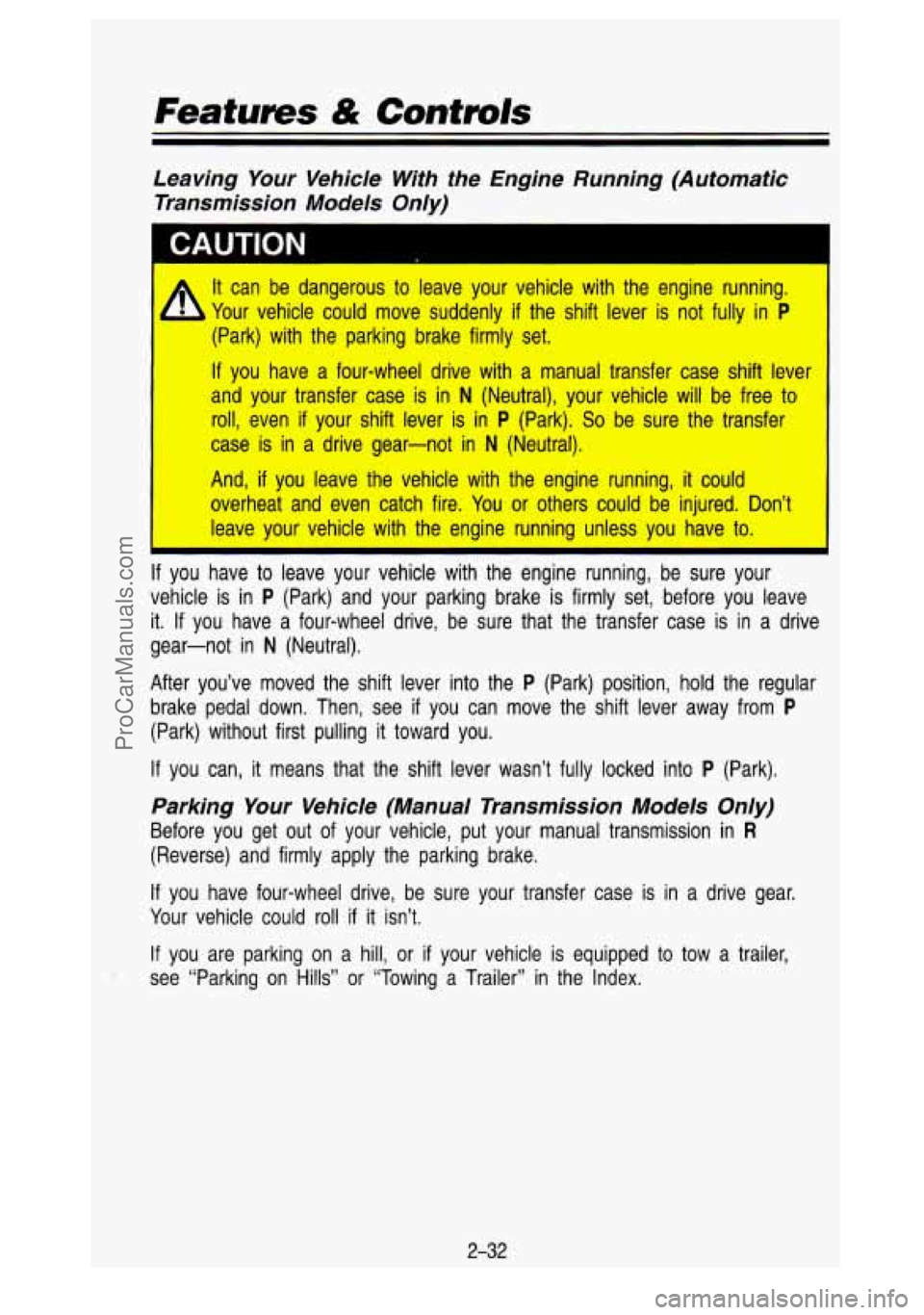
Leaving Your Vehicle With the Engine Running (Automatic
Transmission Models Only)
I CAUTION
A It can be dangerous to leave your vehicle with the engine running. 1
1 Your vehicle could move suddenly if the shift lever is not fully in P
(Park) with the parking brake firmly set.
If you have a four-wheel drive with a manual transfer case sh\
ift lever
and your transfer case
is in N (Neutral), your vehicle will be free to
roll, even
if your shift lever is in P (Park). So be sure the transfer
case is in a drive gear-not in
N (Neutral).
And,
if you leave the vehicle with the engine running, it could
overheat and even catch fire. You or others could be injured. Don’t
leave your vehicle with the engine running unless you have to.\
If you have to leave your vehicle with the engine running, be su\
re your
vehicle
is in P (Park) and your parking brake is firmly set, before you leav\
e
it. If you have a four-wheel drive, be sure that the transfer case i\
s in a drive
gear-not in
N (Neutral).
After you’ve moved the shift lever into the
P (Park) position, hold the regular
brake pedal down. Then, see
if you can move the shift lever away from P
(Park) without first pulling it toward you.
If you can, it means that the shift lever wasn’t fully locked into
P (Park).
Parking Your Vehicle (Manual Transmission Models Only)
Before you get out of your vehicle, put your manual transmission in R
(Reverse) and firmly apply the parking brake.
If you have four-wheel drive, be sure your transfer case is in a\
drive gear.
Your vehicle could roll
if it isn’t.
If you are parking on a hill, or if your vehicle is equipped to tow a trailer,
see “Parking on Hills” or “Towing a Trailer” in the\
Index.
2-32
ProCarManuals.com